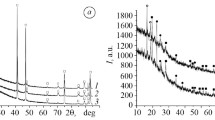Abstract
We used an electrochemical method to etch cast binary titanium alloys in an attempt to show their dendritic structures.Studies showed that when an alloy could be activated in either sulphuric, oxalic or fluosilicic acid, its anodic polarization curve had the same general shape and passivation potential for all alloys independent of alloying element or concentration. Consequently, in acid solutions, electrochemical etching was conducted at a constant potential slightly less noble than the passivation potential where the anodic current density was near the maximum. Of the alloys examined, only Ti-15%Cr was etchable in a concentrated caustic solution and etching occurred only in the transpassive potential region. Under our conditions we were able to show the dendritic structure in alloys containing 15%Cr, Ta, or Mo; at lower concentrations, or in the case of the 15%Nb alloy, the dissolution rates of the dendritic and interdendritic materials were too similar to differentiate between them on the etched surface.
Similar content being viewed by others
References
H. R. Odgen and F. C. Holden, ‘Metallography of Titanium Alloys, TML-103’, Titanium Metallurgical Laboratory, Battelle Memorial Institute, Columbus, Ohio, 29 May, 1958, Appendix C.
M. Stern and H. Wissenberg,J. Electrochem. Soc. 106 (1969) 755.
N. D. Tomashov, R. M. Altovsky and G. P. Chernova,ibid. 108 (1961) 113.
J. C. Griess,Corros. 24 (1968) 96.
T. G. Gooch, J. Honeycomb and P. Walker,Brit. Corros. J. 6 (1971) 148.
C. Edeleanu,J. Iron Steel Inst. 185 (1957) 482.
Y. M. Kolotyrkin, L. M. Nerodenko and L. N. Yagupol'skaya,Ind. Lab. 38 (1972) 357.
H. Hughes,J. Iron Steel Inst. 204 (1966) 804.
F. Mansfeld,Corros. 38 (1982) 556.
M. Pourbaix, ‘Atlas of Electrochemical Equilibria in Aqueous Solutions’, 2nd ed., National Association of Corrosion Engineers, Houston, Texas, and Cebelcor, Brussels (1974).
A. D. McQuillan and M. K. McQuillan, ‘Titanium’, Academic Press, New York (1956).
N. D. Tomashov, Yu. S. Ruskol, G. A. Ayuyan, Yu. M. Ivanov, G. M. Plavnik and R. I. Nazarova,Prot. Metal. 9 (1973) 7.
N. D. Tomashov, T. V. Chukalovskaya, G. P. Chernova, P. B. Budberg and A. L. Gavze,ibid. 8 (1972) 1.
J. M. Peters and J. R. Myers,Corros. 23 (1967) 326.
J. I. Nurminen and H. D. Brody in ‘Titanium Science and Technology, Proceedings of 2nd International Conference, 1972’, Vol. 3, edited by R. I. Jaffee, Plenum Press, New York (1973).
Author information
Authors and Affiliations
Rights and permissions
About this article
Cite this article
Griess, J.C., David, S.A. & Gray, R.J. Electrochemical etching of titanium alloy castings. J Appl Electrochem 14, 573–585 (1984). https://doi.org/10.1007/BF00626301
Received:
Issue Date:
DOI: https://doi.org/10.1007/BF00626301




